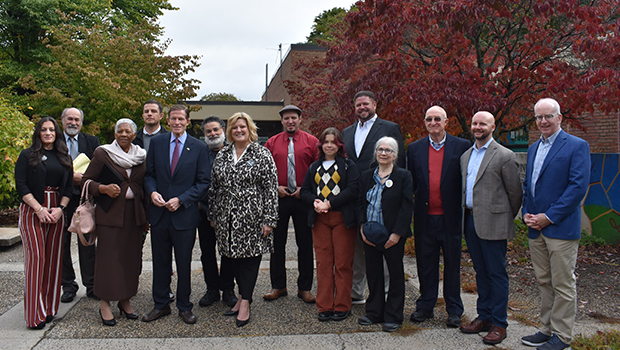With temperatures dropping, flu season set to make a strong comeback, and the clock running out on HVAC grants for schools, CEA President Kate Dias, Senator Richard Blumenthal, and other partners in Connecticut’s Coalition for Healthy Air in Schools are again stressing the need for school districts to apply for HVAC funding before it’s too late.
To deliver their message, coalition members—including parents, teachers, health and safety experts, HVAC technicians, and children’s, employees’, and environmental health advocates—gathered this morning outside the Quinnipiac School, one of two New Haven schools permanently closed due to faulty heating and ventilation systems. More than 60 percent of the city’s school buildings are at least 20 years old, with mechanical systems nearing the end of their useful life—a situation common in districts throughout the state.
 “I can’t think of anything more important than the quality of air breathed by our students, teachers, and staff in our schools,” said Senator Blumenthal, pointing out that 53 percent of Connecticut’s schools are operating with heating, ventilation, and air cooling systems past their intended lifespans—and that most students’ and teachers’ waking hours are spent in those buildings. The senator emphasized the need for a constant stream of federal funding to address outdated HVAC systems so that the burden does not fall to municipalities and local boards of education.
“I can’t think of anything more important than the quality of air breathed by our students, teachers, and staff in our schools,” said Senator Blumenthal, pointing out that 53 percent of Connecticut’s schools are operating with heating, ventilation, and air cooling systems past their intended lifespans—and that most students’ and teachers’ waking hours are spent in those buildings. The senator emphasized the need for a constant stream of federal funding to address outdated HVAC systems so that the burden does not fall to municipalities and local boards of education.
Millions of dollars in federal grants have already been made available, but the deadline for school districts to apply for those loans—December 1, 2022—is fast approaching.
“This issue has been long-standing on our agenda,” said Dias, who recalled her own Manchester High School classroom reaching 95 degrees in the summer months and dipping to 50 degrees in the winter. The pandemic, she said, shined a light on the problem as teachers who were able to open their windows often had to—just to keep air circulating.
“It snowed in my classroom,” Dias said.
She added, “We are in the midst of a teacher shortage, and this is a piece of the puzzle. Providing, healthy and vibrant working conditions is a part of attracting the best of the best. If we are to continue to maintain a top-tier education system, then we need to maintain our competitiveness in all categories—and our facilities are one of those. Pet stores have air quality standards; school buildings should have standards too.”
 Echoing Dias’s sentiments, New Haven middle school teacher Michael Soares, a parent of two public school students, shared, “Teachers, administrators, and school staff know that our working conditions are students’ learning conditions, and teachers and students have the right to work and learn in safe, healthy buildings. We all know the stories: broken HVAC systems, mold, inadequate heating and cooling, dust blowing out of air vents, windows that do not open. Now is the time for school districts to apply for funding to make sure that all of our Connecticut teachers and students thrive in safe and healthy classrooms.”
Echoing Dias’s sentiments, New Haven middle school teacher Michael Soares, a parent of two public school students, shared, “Teachers, administrators, and school staff know that our working conditions are students’ learning conditions, and teachers and students have the right to work and learn in safe, healthy buildings. We all know the stories: broken HVAC systems, mold, inadequate heating and cooling, dust blowing out of air vents, windows that do not open. Now is the time for school districts to apply for funding to make sure that all of our Connecticut teachers and students thrive in safe and healthy classrooms.”
On the subject of indoor air quality, Connecticut Council on Occupational Safety and Health Co-Chair Steve Schrag said, “We have been dealing with this issue for a long, long time. Every child in every classroom in every school in every town in Connecticut deserves to go home healthy. So do those who work in those schools. This is not just a safety issue; this is an environmental justice issue. Poorer communities have the oldest schools, often with inadequate ventilation systems.” He added, “Without funding, most school systems won’t make this a priority. That’s the carrot. We also need a stick to go with that carrot.”
 The stick, he said, needs to be a comprehensive OSHA standard to protect those who raise their voices about problems, since many fear retaliation.
The stick, he said, needs to be a comprehensive OSHA standard to protect those who raise their voices about problems, since many fear retaliation.
Blumenthal agreed and added, “There’s no underestimating the importance of the unions. They are instrumental here.”
Also speaking to the urgency of applying for $150 million in HVAC grants was Joellen Lawson, founder and president of the Connecticut Foundation for Environmentally Safe Schools, whose career as a special education teacher was cut short because of permanently disabling health issues directly linked to air pollution exposure at the school where she had worked. Among the issues in her former school building, which was eventually shut down and razed, were deferred maintenance, mold contamination, inadequate ventilation, and the absence of an effective IAQ management plan.
Representing the Associated Sheet Metal and Roofing Contractors of Connecticut, Matthew Cole spoke not only as an air quality assessment expert but also as a parent of school-aged children.
 “The path to better indoor air quality in Connecticut’s schools starts with understanding our needs,” he said. “Proper IAQ goes beyond COVID. It lowers transmission of colds and flu and instances of asthma. It improves attendance rates. Healthy indoor air quality, along with proper air temperature and humidity, improve student performance and create a productive environment.”
“The path to better indoor air quality in Connecticut’s schools starts with understanding our needs,” he said. “Proper IAQ goes beyond COVID. It lowers transmission of colds and flu and instances of asthma. It improves attendance rates. Healthy indoor air quality, along with proper air temperature and humidity, improve student performance and create a productive environment.”
Cole urged municipalities to schedule ventilation assessments for their schools—which would be covered by grant funding—as a critical first step.
“We can breathe easier if our students and teachers breathe easier,” Blumenthal said.







